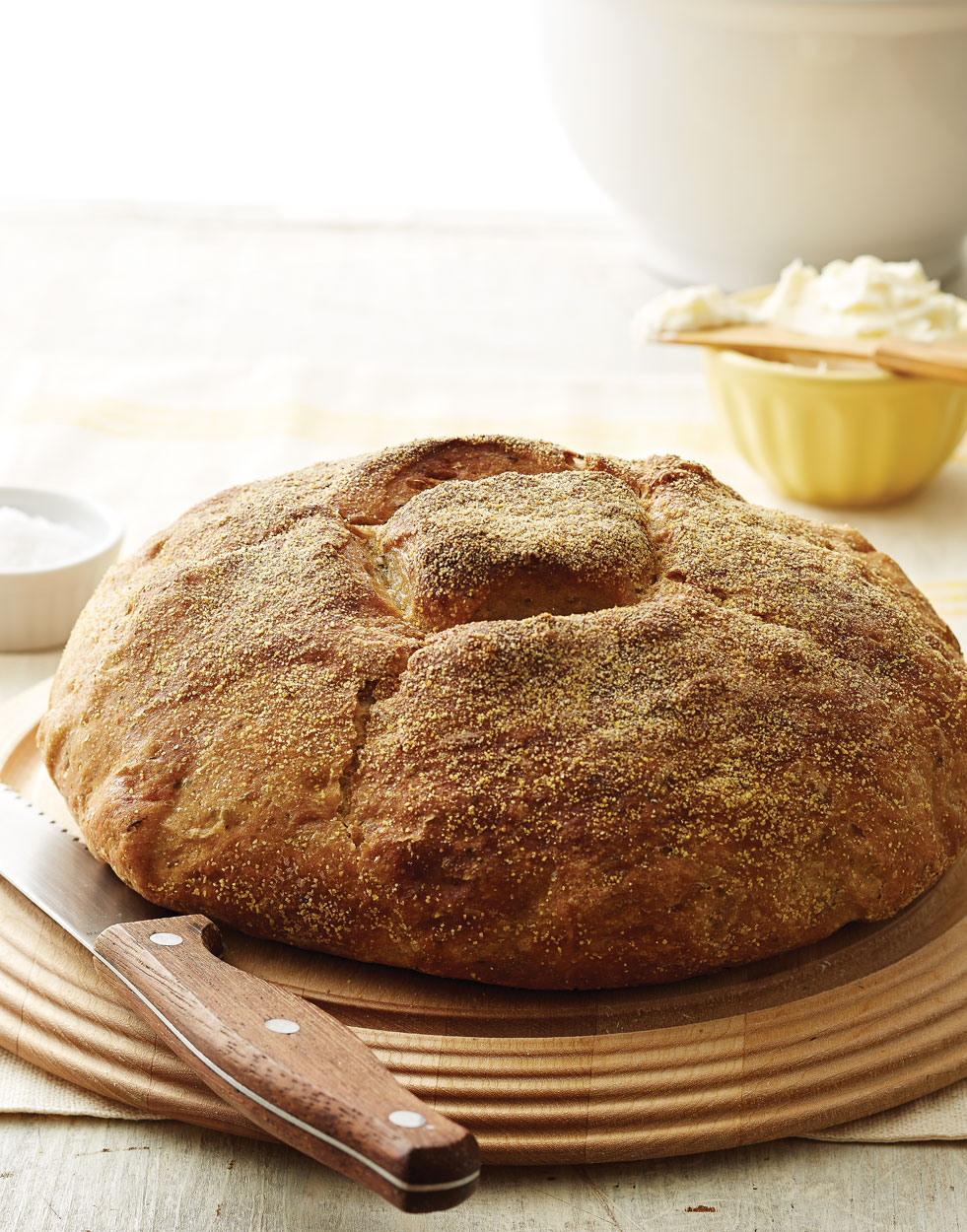
Side Dishes
No-Knead Whole-Wheat Bread with Black Pepper & Herbs
Man may not live by bread alone — but with an artisan loaf this good and this easy to make, you might want to.
With an open, chewy crumb and crackled crust, there’s nothing quite like an artisan loaf of bread. But why are so many people intimidated to try their hand at making it? Likely because yeast and kneading are involved. And while you can’t make a loaf of bread without yeast, you can without kneading — you just need time and a little patience.
This method, which is as easy as stir, rest, and bake, is based on the popular Sullivan Street Bakery’s technique. It takes about 24 hours to create a boule — one round loaf. It’s that long resting time, plus a couple of other factors, like baking in a Dutch oven, that produces a loaf that’s as good as any artisan bread.
Once you learn the tricks of the trade, you can create your own loaf. So, it doesn’t matter if you’re a savory or sweet fan, there’s a slice — with amazing taste and texture — just waiting for you.
Ingredients
WHISK:
STIR IN:
No-Knead Bread Basics
While this is basically a fuss-free technique, there are a few things to keep in mind for success.
IN BALANCE: Bread recipes are based on a percentage (balance) of ingredients, such as flour and water. To achieve that balance, weigh your flour and water. And to maintain the right pH balance, for proper fermentation, be sure to use purified drinking water.
STICKY STUFF: Don’t be alarmed that the dough is wet and sticky — it’s supposed to be. The high water content in the dough actually creates the right humidity while baking, which results in the crackled crust (and is why professional bakers use steam-injected ovens to bake their bread).
TIME IS ON YOUR SIDE: Once the dough is mixed, let it ferment (rise) for 12–20 hours. The longer the fermentation, the better the taste and structure of the bread. And it’s that long fermentation, requiring very little yeast, that naturally accomplishes what kneading does — it brings the gluten molecules into side-byside alignment so they’re able to produce a strong, elastic framework.
SHAPE UP: Because it’s a sticky dough, use plenty of flour on your work surface and on your hands when shaping the dough.
ROCK & PAPER: To help form the dough (and avoid burning yourself later) transfer the dough to a 10-inch skillet lined with greased parchment paper (which you can then hold onto when transferring the dough to the preheated Dutch oven).
PLUS SCISSORS: Just before baking, cut the top of the dough with kitchen shears to degas it and improve the rise.
GOING DUTCH: Basically you can use any 5- to 7-qt. heavy pot with a tight-fitting lid that can withstand the intense heat required for preheating and baking. A cast-iron Dutch oven maintains the heat properly, but a heavy stainless pot works as well.
RUNNING HOT & COLD: To make sure the bread is completely baked (and not gummy), first temp it, so you know it’s done, then — and perhaps hardest of all — let it cool completely before slicing.
Instructions
Whisk together all-purpose flour, whole-wheat flour, thyme, rosemary, salt, pepper, and yeast in a large bowl.
Stir in water, using a wooden spoon or rubber spatula, until well-combined into a wet, sticky dough, about 30 seconds.
Transfer dough to a lightly oiled bowl; cover with plastic wrap.
Let dough rest in a draft-free area at room temperature (about 75°), out of direct sunlight, until surface is dotted with bubbles and dough doubles in size, 12–20 hours.
Arrange a 12×18-inch sheet of parchment paper inside a 10-inch skillet and coat with nonstick spray.
Transfer dough, with lightly floured hands, onto a generously floured work surface. (Dough will be loose, sticky, and will flatten and spread on surface.)
Shape dough into a ball by pulling edges to middle and loosely pinching it closed.
Transfer dough, seam side down, to prepared skillet; loosely cover with plastic wrap coated with nonstick spray. Let dough rise at room temperature until it’s nearly doubled in size and does not readily spring back when poked, 1½–2 hours.
Preheat oven to 475° with a 5- to 7-qt. covered Dutch oven or heavy pot inside, at least 30 minutes before dough is ready.
Meanwhile, lightly sprinkle cornmeal over top of dough to add texture and a rustic look. Cut an “X” or square pattern in top of dough with kitchen shears.
Carefully remove Dutch oven from oven and remove lid. Transfer dough with parchment paper to Dutch oven, allowing excess parchment to hang over edges.
Cover Dutch oven and return to oven; bake 35 minutes. Carefully remove lid and bake loaf until browned and an instant-read thermometer inserted into the center registers 207–209°, about 10 minutes more.
Carefully remove bread from Dutch oven, discard parchment, and transfer to a wire rack to cool, about 2 hours.
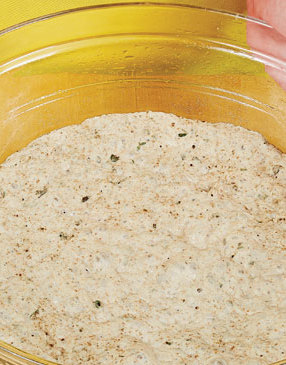
The dough is ready for shaping when the surface is dotted with bubbles and it has doubled in size.
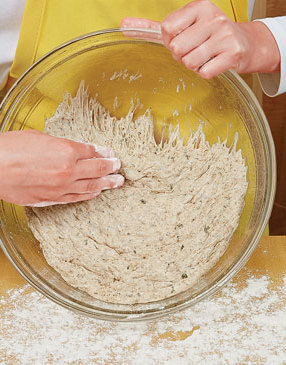
Nudge the dough with your fingers. Don’t worry that it clings in long strands, this is the developed gluten.
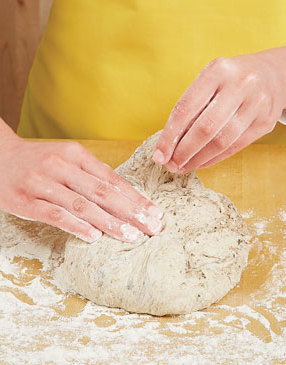
To shape the dough into a ball, pull the corners and edges into the middle, then pinch it closed.
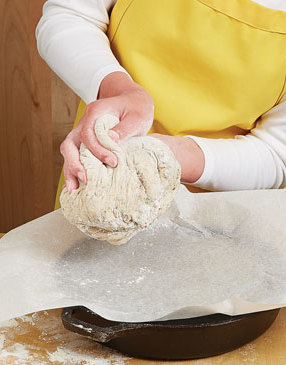
To help the dough hold its shape, flip the ball-shaped dough and place in a 10-inch skillet seam side down.

The dough is ready for baking when it doesn’t readily spring back when pressed with your fingers.
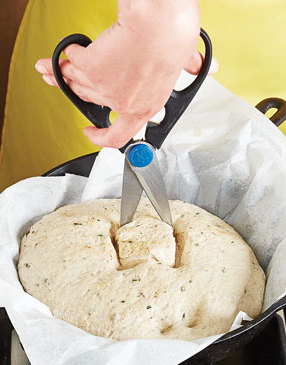
Cutting the top of the dough lets the gases escape so they don’t escape elsewhere, splitting the loaf.
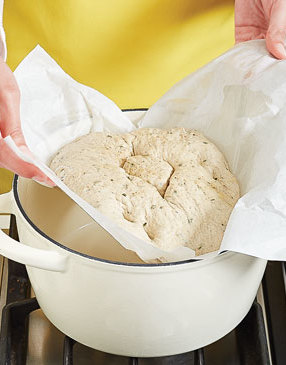
Easily transfer the dough to the HOT pot by grabbing the excess parchment, then cover and bake.
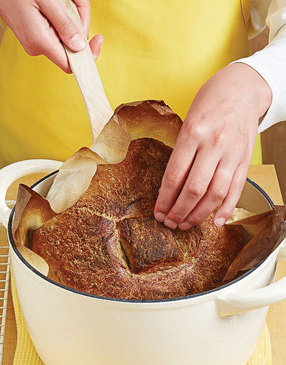
Greased parchment also helps keep the bread from sticking to the pot while baking.
Nutritional Facts
Nutritional Facts
Per serving
Calories: 96
% Daily Value*
Total Fat 0g 0%
Saturated Fat 0g 0%
Cholesterol 0mg 0%
Sodium 219mg 9%
Carbs 21g 7%
Fiber 1g 4%
Protein 3g
*Percent Daily Values are based on a 2,000 calorie diet.